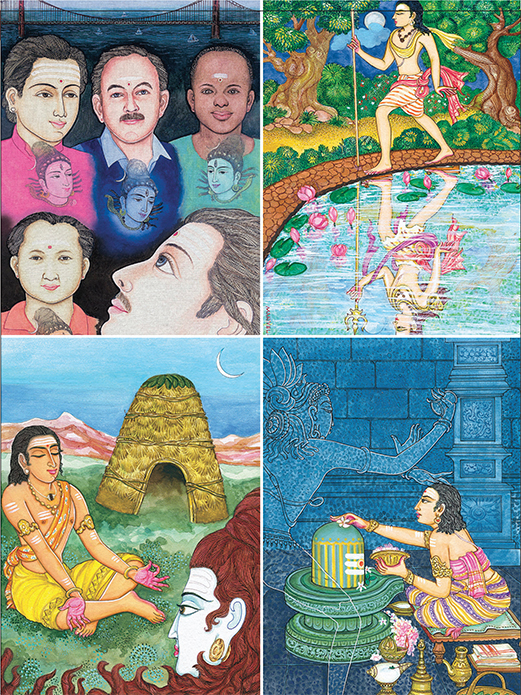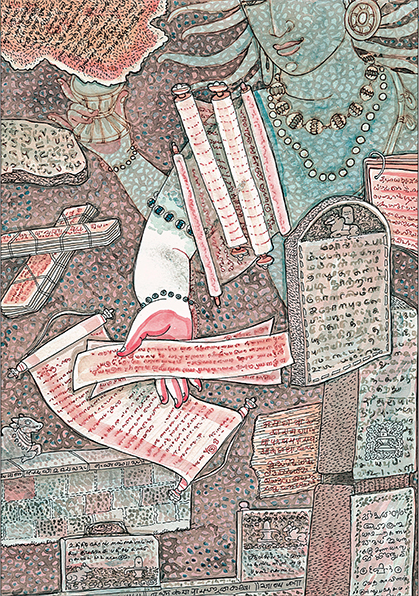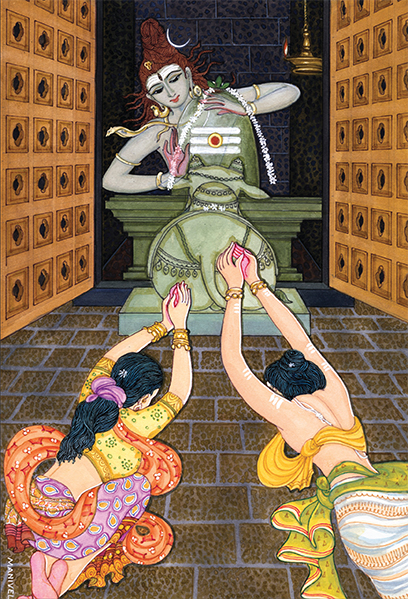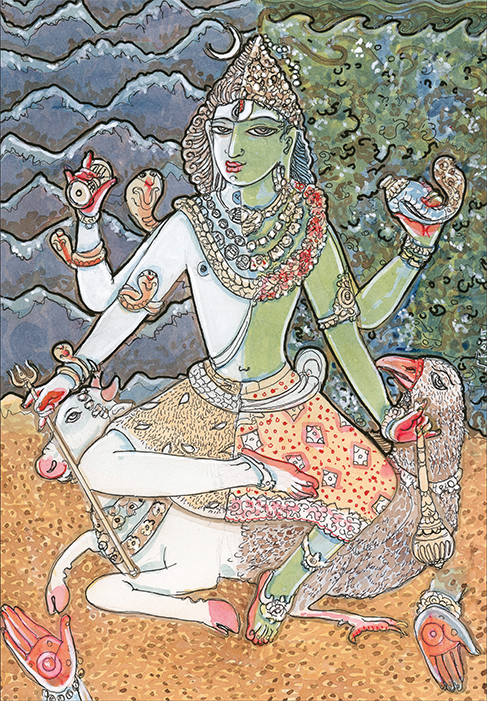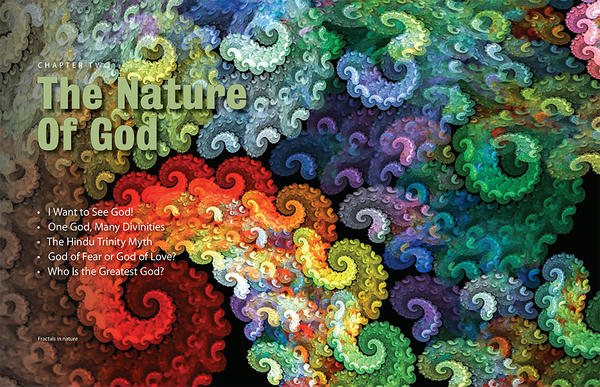
PUBLISHER’S DESK • JULY 2018§
“I Want to See God!”
______________________§
Some pertinent suggestions to sincere seekers on where and how to look for Divinity§
______________________§
BY SATGURU BODHINATHA VEYLANSWAMI§
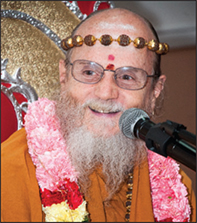 THE FOCUS OF MANY RELIGIONS IS ON HELPING those who do not believe in God to believe in God. For them, belief in God is the beginning and the end of the process. Once you believe in God, there is nothing more to do. However, in Hinduism belief is only the first step. Hindus want to move beyond just believing in God to experiencing God for themselves.§
THE FOCUS OF MANY RELIGIONS IS ON HELPING those who do not believe in God to believe in God. For them, belief in God is the beginning and the end of the process. Once you believe in God, there is nothing more to do. However, in Hinduism belief is only the first step. Hindus want to move beyond just believing in God to experiencing God for themselves.§
There is a classic story from the life of Swami Vivekananda, one of Hinduism’s most well-known modern teachers, that illustrates the Hindu perspective of experiencing God. When Vivekananda was still a university student, he asked many of the foremost religious leaders in the Calcutta area where he lived if they had seen God. It was, in part, his college-age intellectual challenge to their religiosity. He never got a clear and authoritative answer from anyone until he met Sri Ramakrishna. It was during his second meeting with the saint that he asked the question, “Sir, have you seen God?” Calmly Sri Ramakrishna replied, “Yes, I see Him as clearly as one sees an apple in the palm of the hand; nay, even more intently. And not only this, you can also see Him.” This deeply impressed the young Vivekananda, who soon after accepted Sri Ramakrishna as his guru.§
Ramakrishna was taking the young seeker beyond belief in God and pointing toward direct experience of the Divine. It is clear that the Hindu’s belief in God is only a step toward the eventual experience of God. An important second point is that in Hinduism the experience of God, in the sense of complete God Realization, is the ultimate goal of life. It is an experience we will all eventually have when our soul has achieved sufficient spiritual maturity. It is the experience which liberates us from the need to be reborn on Earth. It is, to the Hindu, everybody’s goal.§
A great saint of North India, Anandamayi Ma, stated the goal of God Realization quite beautifully: “Man is a human being only so much as he aspires to Self Realization. This is what human birth is meant for. To realize the One is the supreme duty of every human being.” In our own guru parampara, Satguru Yogaswami thundered a similar mahavakya (great saying): “Tanai Ari,” “Know thy Self.” His disciple Markanduswami liked to stress that “Yogaswami didn’t give us a hundred-odd works to do, only one: ‘Realize the Self yourself,’ or ‘Know thy Self’ or ‘Find out who you are.’” “Yogaswami said, ‘You can’t find the truth in a thousand books or by listening to people talk. You must realize the Self by yourself!’ “§
This experience is called God Realization or Self Realization. Hinduism distinguises between self with a small s, which is the ego, and Self with a capital S, which is the soul. In Western self-improvement terminology, self realization refers to manifesting the full potential of your outer self. In Hinduism, the first step toward realizing the Self is claiming one’s identity as a spiritual being, a divine soul. The next step is realizing the soul’s essence, which at the deepest level is also God’s essence, so in experiencing our inmost nature we also experience God.§
Besides God, religion is also concerned about evil. Again, Hinduism looks at evil as internal to man, not external. Evil relates to man’s instinctive nature, which is capable of wrong actions based in anger and violence. We can say that man’s nature is threefold: instinctive, intellectual and spiritual. The goal is to subdue the instincts, direct the intellect, harness the ego and manifest the spiritual nature.§
Though many individuals are inspired by the thought of seeing God, to most, the experience seems distant and unattainable. This is because they think of jumping somehow from a zero percent consciousness of God’s presence to 100 percent awareness of God’s presence. This is where one’s concept of enlightenment may be a barrier—that enlightenment is an instantaneous event coming out of nowhere, totally transforming us like a flash of lightning. It is more helpful to think of enlightenment as a gradual process which involves increasing our control over our instinctive nature, directing our thoughts better and expressing more and more of our innate Divinity. Said another way, we do not need to wait for the total, transforming and liberating experience of complete God Realization to know God in simpler ways. This approach allows us to start seeing God now.§
Let’s look now at some specific suggestions on where and how to first look for God. To experience God, do we sit on a mountaintop, go into a cave or simply close our eyes? Where do we go to see God? Perhaps the easiest place to start is to see God in great religious teachers. We feel a spiritual aura about them that is uplifting. We see a light in their eyes that we do not see in others’. The mere sound of their words encourages us to live a more spiritual life.§
Another way to see God, which is a little more difficult but still easy to do, is to look deeply into the eyes of another person. Look beyond the personality, go deeper than his or her intellect and see the pure life energy, which is God. The great saying, mahavakya, that describes this approach to experiencing the Divine is found in the Tamil word Uyirkkuyir, “God is the Life of our life.”§
This practice does not stop with people, but should also include trying to see the life energy in trees, birds and animals. This is because God is our life. God is the life in all beings. Becoming aware of this life energy in all that lives is becoming aware of God’s presence within us. A beautiful verse from the Brihadaranyaka Upanishad elucidates this concept: “He who knows God as the Life of life, the Eye of the eye, the Ear of the ear, the Mind of the mind, he indeed comprehends fully the Cause of all causes.” In Hindu culture, every time we greet another person with the traditional gesture of namaskar, we have the opportunity to practice looking deeply enough into his or her eyes to see God within as the life of their life. This is fulfilling the deepest meaning of namaskar, which means, “I greet God in you.”§
A third place to look for God is in the Hindu temple. This is the devotional or theistic approach. The Hindu temple is not simply a place we go to socialize or listen to lectures on Hinduism. It is a sacred place, built and maintained in such a way that we can go there and experience the Divine. Invoked by ordained priests through daily puja rituals, the Gods and angelic beings, or devas, in the inner, spiritual worlds are able to bless us through the Deity’s image in the temple. The image is like a temporary physical body the Gods use during temple ceremonies.§
Though a devotee may have a vision of God, the more common way we experience the Gods and devas is as an uplifting, peaceful energy, or shakti, that radiates out from the image. It is easiest to feel these blessings at the peak of the puja, when the flame is held high. The Gods’ blessings are most strongly felt on their major festival days, such as Vinayaga Chaturthi for Lord Ganesha.§
A fourth place to look for God is within ourselves, through the practice of meditation. Meditation is internal worship—going deeply enough into ourself to find that part of us that is identical with God. At first we experience God as peaceful and blissful feelings, later as a brilliant, clear white light, later still as a consciousness that permeates all, and finally as Transcendent Reality, which is timeless, formless and spaceless.§
Meditation is the essence of ashtanga yoga, which means “eight limbs.” The first two limbs, which are often glossed over by eager yoga students, are yama and niyama, Hinduism’s ten ethical restraints and ten religious observances. These form a very necessary, secure basis for meditation, a foundation of good character without which no progress in spiritual life can be made. The restraints are noninjury, truthfulness, nonstealing, divine conduct, patience, steadfastness, compassion, honesty, moderate appetite and purity. The observances are remorse, contentment, giving, faith, worship of the Lord, scriptural listening, cognition, sacred vows, recitation and austerity. Once this platform of virtuous living is established, ashtanga yoga’s subsequent six limbs can be pursued, beginning with asana (sitting quietly in yogic posture) and pranayama (breath control). Then pratyahara, sense withdrawal, brings awareness into dharana, concentration, then into dhyana, meditation. Dhyana finally leads to samadhi, God Realization.§
The key to deepening our experience of God is the regular practice of spiritual disciplines. And it is fair to say that no other religion contains such a vast range of spiritual practices, from such fundamental virtues as noninjury and purity, to temple worship, advanced yoga practices and meditation.§
Even though God pervades us and the entire universe, in the beginning stages we don’t see Him. This is because He has intentionally hidden Himself from us, allowing us freedom to grow and learn through experience and eventually strive to find the Self within. This is called His veiling grace. Once we awaken to a certain stage and yearn with all our heart to see and know God, we can do so by seeing Him in great religious teachers, in the eyes of other people, and by seeing Him as the Life of the life within all that lives. In the temple we can experience God’s peaceful energy, or shakti. And within ourself, we can come to know God through the fine art of meditation. Through all these joyous spiritual practices of Hinduism, we can become more and more aware of God’s presence within and around us. But be patient! This is a gradual process. It takes practice, lifetimes of practice.§
PUBLISHER’S DESK • OCTOBER 2017§
One God, Many Divinities
______________________§
A guide to the complexities of Deity images in Hindu temples and the nature of our temple consecration rites§
______________________§
BY SATGURU BODHINATHA VEYLANSWAMI§
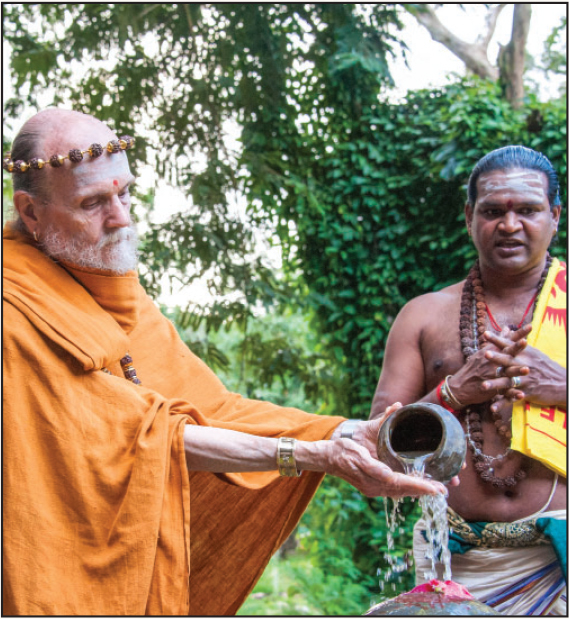 RECENTLY I GAVE A TALK AT THE MAHA Kumbhabhishekam (consecration) for the Enfield Nagapooshani Ambaal Temple in London. Since many present at the event were new to Hinduism, I began with a basic introduction to the temple itself. Here is my message.§
RECENTLY I GAVE A TALK AT THE MAHA Kumbhabhishekam (consecration) for the Enfield Nagapooshani Ambaal Temple in London. Since many present at the event were new to Hinduism, I began with a basic introduction to the temple itself. Here is my message.§
One’s first visit to a Hindu temple can easily give the impression that Hinduism has a multiplicity of Supreme Gods. That can be a natural assumption, given the many shrines and holy images one encounters. However, it is not correct. While Hindus do believe in many Divinities, all believe in a One Supreme Being. A verse from Hinduism’s oldest scripture, the Rig Veda, is often quoted to express this idea. In Sanskrit it states: “Ekam Sat, viprah bahudha vadanti,” and in English it reads “Truth is One; sages describe it variously.” In a Hindu temple it is not uncommon for the Supreme Being to have more than one shrine. In each of these shrines God is depicted in a different way, such as male, female, both male and female, dancing or blessing. At the Enfield temple, in the main shrine we encounter the Supreme Being in the form of the Goddess Nagapooshani Ambaal, following a tradition from Nainativu, an island near Sri Lanka’s northern peninsula. In this London temple, the Supreme Being is represented in four other forms as well: Sivalingam, Lord Nataraja, Dakshinamurti and Bhairava. We might find a parallel in a Christian church where Jesus is worshiped on the cross, in a manger and with the apostles. Jesus is a one Lord, but with different forms and meanings. Seeing his multiple images, we do not conclude there are multiple Christian Lords.§
Like the Abrahamic religions, Hinduism believes God has created great divine beings to perform various functions. The Abrahamic traditions call these archangels; Hindus call them Lords, Divinities or Gods—while not mistaking them for God! Most Hindu temples have side shrines dedicated to some of these great beings. The Enfield temple, for example, contains shrines to Lords Ganesha, Muruga and Anjaneyar. These divine beings are secondary to the main Deity, just as archangels, such as St. Michael, are secondary to the Supreme Being in Abrahamic faiths.§
Over fifty churches in the greater London area are named St. Michael’s Church. Who is St. Michael? He is not, in fact, a saint but the chief among angels, patron of warriors, mariners and the suffering. Three other archangels—Raphael, Gabriel and Uriel—are often glorified; London has churches dedicated to both Raphael and Gabriel. Some Jewish traditions recognize as many as ten archangels. These beings, like the Hindu Divinities, function as helpers of God, fulfilling specific responsibilities. A Christian or Jew worshiping St. Michael or Mother Mary is not worshiping a second Supreme God, but rather an elevated being who enjoys God’s grace. Similarly, in a Hindu temple we have a one God, but many blessed and heavenly Divinities, helpers of the Creator of all.§
In understanding the nature of God and Divinities in the Hindu temple, there is a third factor to consider. The Hindu religion is not a single, homogenous faith; it is a complex family of faiths that, while similar, are also different one from the other.§
Most obviously, the three main denominations worship the Supreme Being by a different name. To Saivites, God is Siva. To Vaishnavites, God is Vishnu; and Shaktas venerate the Supreme as Shakti. In many temples, especially in the diaspora, these traditions overlap. Thus, in the Enfield temple, which is of the Saiva denomination, there is a major shrine to Lord Vishnu, the form of the Supreme Being worshiped by Hindus of the Vaishnava denomination. While this presence of seemingly distinct Supreme Gods can confound outsiders, Hindus know what is being represented, and rather enjoy the inclusivity of it all. There are few sharp lines in this elastic, all-embracing family of faiths. At the same time, the strictest of Vaishnavites would not have an image of Siva in their temple, and the most traditional of Saivites would never allow a Krishna in theirs.§
This blending has been fostered by Hinduism’s fourth major denomination, the prominent Smarta Sampradaya. This liberal Hindu stream of philosophy, culture and tradition brings together, on personal altars and in public temples, all three major forms of the Supreme Being—Vishnu, Siva and Shakti—as well as secondary Divinities, especially Ganesha, Surya and Muruga. All are seen as equal reflections of the one Saguna Brahman, and any one of them may be worshiped as the Supreme Being. In some temples following this ultra-inclusive pattern, one may even find altars to Jesus, Mother Mary, Mohammed or Buddha.§
Another subtlety Hindus enjoy that could confound non-Hindus regards gender. While philosophically God is beyond gender, He/She is commonly represented as male or as female, or both. Hence the Goddess is revered not only in Shaktism, but in Vaishnavism and in Saivism as well, though by different names and personalities. This is the subtle explanation behind the Supreme Being in the Enfield Temple being worshiped in the personage of Nagapooshani Ambaal (Shakti), surrounded by various forms of Siva, including Nataraja and Sivalingam. Despite the separate shrines, Shakti/Siva are philosophically understood as one and inseparable. §
The Consecration Rites§
Our second topic is the nature of the ceremony that is performed to give life and spiritual power to a temple. In Sanskrit it is called kumbhabhishekam, a term sometime preceded by maha, meaning “great.” Kumbhabhishekam is the combination of the two words kumbha, a water vessel, and abhishekam, the rite of pouring kumbhas filled with sanctified water over the copper spires (which resemble inverted kumbhas) on the crown of the temple. Kumbhabhishekam names the formal inauguration of a new temple and its periodic reconsecration, usually at twelve-year intervals, following renovation, extensive cleaning and renewal.§
The English term for such a ceremony is consecration, meaning “to make sacred.” For such a blessing to be holy, God’s presence must be invoked. At a mahakumbhabhishekam, this is done through priestly disciplines and sacred fire ceremonies called homa or yajna, conducted in a temporary structure called a yagasala built just for that purpose. Fire is used in many religions in one form or another. In Hinduism it is believed that fire can be seen in the heavenly inner worlds. By lighting a fire, intoning sacred chants and ringing a bell, we invite benevolent inner-world beings to come and bless all present. These blessings build in intensity and accumulate over a number of days in the water pots near each sacred fire. On the final day, the water in the pots is poured over the temple spire and bathes the various Deities and objects being made sacred. This holy ablution occurs at the high point of the ceremony. It is preceded by days of ceremonies and followed by a month of special daily rituals.§
Significance of Deity Images§
Our third topic is the use of statues in Hindu worship. As part of the kumbhabhishekam ceremonies, all the statues that are being installed in the shrines are purified and infused with divine energy. Thereafter, the statue is considered a murti, an image that has been made worthy of worship and in which the Deity is present. In other words, the great inner-world being uses the image as a temporary physical body through which He/She blesses the devotees present. Thus we can see that Hindus are not worshiping the icon itself. They are worshiping the holy Deity within it. Though many regard the image simply as a symbol for God, the most devout and mystical regard it as God Himself or Herself.§
The priestly rituals are based squarely on the principle of invocation: beseeching conscious, intelligent, compassionate higher powers in the inner worlds. Hinduism recognizes multiple planes of existence, unseen worlds filled with souls of all stages of evolution. We experience these subtle, nonphysical dimensions of being in our thoughts and emotions all the time. During sleep, we leave the physical world and become fully active in unseen realms. At death we shed our physical body and reside in the inner planes until we are again born in a physical body.§
PUBLISHER’S DESK • OCTOBER 2005§
The Hindu Trinity Myth
______________________§
How temples can publicize their philosophy and lineage to counteract the misconception that Hinduism is polytheistic§
______________________§
BY SATGURU BODHINATHA VEYLANSWAMI§
 A FEW YEARS AGO A NON-HINDU PROFESSOR who teaches world religions at a Texas University visited our monastery to learn more about Hinduism. His first question was, “Is it true that Hindus worship a trinity of Brahma, Vishnu and Siva? That is what the textbooks teach. That is what the professors tell their students.” Though I was aware of the wide scope of this misconception, I was aghast to see it taken as fact.§
A FEW YEARS AGO A NON-HINDU PROFESSOR who teaches world religions at a Texas University visited our monastery to learn more about Hinduism. His first question was, “Is it true that Hindus worship a trinity of Brahma, Vishnu and Siva? That is what the textbooks teach. That is what the professors tell their students.” Though I was aware of the wide scope of this misconception, I was aghast to see it taken as fact.§
We explained to him that this idea is based on stories from the Puranas, but it has no relevance in actual Hindu practice or theology. Some texts seek to draw credence for this idea from the massive trimurti (three-faced) stone carving of Brahma, Vishnu and Maheshvara as one being in the Elephanta Caves (ca 700). However, a more sensible view is that this 16-foot-tall carving is a paradigm of the oneness of Divinity. One might even surmise that the Elephanta image was carved to glorify the famous Vedic verse (Maitri Upanishad 5.2): “That part of Him which is characterized by tamas is called Rudra. That part of Him which belongs to rajas is Brahma. That part of Him which belongs to sattva is Vishnu.” Is this a prayer to a trinity of three Gods? No. It is a prayer of adoration to the One Supreme Lord.§
The professor was truly amazed to hear this, having never actually spoken to a Hindu about it before. He thanked us for the clarification and pledged to change his syllabus for the coming year to state that Hindus actually worship a one Supreme Being and are not polytheists. Unfortunately, most teachers of world religions continue to indoctrinate students with the misunderstanding that Hindus are polytheistic. Hindus were never polytheistic in the sense that there are many equal Gods. Henotheism (literally “one God”), which philosophers also call inclusive monotheism, better defines the lofty Hindu view. It means the worship of one God without denying the existence of other Gods.§
Whether there is one or more Supreme Gods can be traced to two distinct but intertwining streams of Hindu thought and tradition. There is the original Vedic-Agamic Hinduism, with its high-minded philosophical edicts, its vast knowledge about ritual and theology and a wealth of mystical insights into God, man and world. And there is the more recent Puranic Hinduism, with its folk narratives and myths, its teachings of culture and religious practices, its vast record of history, architecture, medicine and geography and, of course, the popular and sometimes implausible stories about the Gods. Vedic-Agamic Hinduism is ancient, for the authoritative Vedas and Agamas have their source deep in human history, 6,000 to 8,000 years ago, while Puranic Hinduism is more recent and based on secondary scripture.§
Another source of confusion in this regard is the Hindu temple itself, when not properly explained. We walk in the door and encounter a multiplicity of shrines, each with a different Deity. How does the onlooker reconcile the one Supreme God of the Upanishads with the profusion of Gods we encounter in the temple? This final section of the Vedas states that God is the Supreme Reality referred to as Brahman, transcendent and immanent, one and indivisible, infinite and eternal, all-pervading, Existence-Knowledge-Bliss—as well as the Personal Lord.§
This is where the knowledge of Hinduism’s four denominations or sectarian traditions is quite helpful. The Tamil Lexicon by the University of Madras defines them as follows: “Saivam: The religion which regards Siva as the Supreme Being and is exclusively devoted to His worship, of sixteen sects. Shaktam: The religion which enjoins the exclusive worship of Shakti as the Supreme Being. Vaishnavam: The religion which holds Vishnu to be the Supreme Being.” The definition for the Smarta or Vaidika Sampradaya is found under Shanmatam: “The six Vedic religious systems: Saivam, Vaishnavam, Shaktam, Ganapatiya, Kaumaram, Sauram.” In other words, Smartas have a choice to worship any one of the six Deities—Siva, Vishnu, Shakti, Ganesha, Subramanya and Surya—as the Supreme Lord, as their Ishta Devata, or preferred Deity.§
However, we don’t want to leave the impression that all Hindu denominations hold the Smarta viewpoint that all Gods are “aspects” of the Supreme Being. In Saivism, for example, God Siva is the Supreme Being and Ganesha and Subramanya are separate Gods who assist Him. These Gods are not symbolic representations, but real spiritual beings, somewhat akin to the archangels of Christianity.§
A uniquely confusing situation we find in the West is that Supreme God Vishnu and Supreme God Siva are sometimes equally enshrined side by side in the same temple to accommodate various allegiances. This gives the wrongful impression that the practicing Hindu worships more than one Supreme God. This problem does not occur in India, where only one Deity is enshrined as the central God in any temple.§
Indeed, we know of US temples which on their website describe Siva as the destroyer and Vishnu as the preserver. Of course, this is not how knowledgeable Saivites or Vaishnavites look at it. To Saivites, Siva is the entire Supreme Being, not merely the dispenser of destruction. To Vaishnavites, Vishnu is the entire Supreme Being, not just the Lord of preservation. That we worship the Supreme Being above all others is clearly the view of Hinduism’s revealed scriptures (shruti), the Vedas and Agamas.§
Not all Hindus are familiar with the category of scripture called the Agamas. The Agamas were part of an oral tradition of unknown antiquity which some experts consider as ancient as the earliest Vedas. The Agamas are the primary source and authority for temple construction and ceremonies. Each of the major denominations—Saivism, Vaishnavism and Shaktism—has its unique Agama texts. Smartas recognize the Agamas, but don’t necessarily adhere to them, relying mainly on the smriti texts, such as the Dharma Shastras, Puranas, Mahabharata and Ramayana.§
In the Saiva Agamas, for example, Lord Siva is described as the Supreme Being, performing all three divine actions of creation, preservation and destruction. Quite often two additional actions are included: His veiling and revealing graces. The Raurava Agama states, “The birth of the world, its maintenance, its destruction, the soul’s obscuration and liberation are the five acts of His dance.” No wonder Saivites take great exception to the statement that Siva is the God of Destruction, a concept that finds its source in the Puranas.§
I have been to a number of temples that have equal shrines for Venkateshvara and Siva. If such a temple took the Puranic approach, it would say that at the Sri Venkateshvara shrine we are worshiping Vishnu, the God of Preservation, and at the Sri Sivalingam shrine we are worshiping Siva, the God of Destruction. In the Agamic approach, we would say the Venkateshvara shrine is of the Vaishnava denomination of Hinduism, which worships the Supreme Being as Vishnu. The liturgy, or temple ritual, is conducted according to the Pancharatra or Vaikhanasa Agama. The Sri Sivalingam shrine is of the Saiva denomination of Hinduism, which worships the Supreme Being as Siva. The liturgy is conducted according to the Kamika and Karana Agamas.§
The misunderstanding created by the Puranas is not a new problem. Arumuga Navalar (1822-1879) was a devout and brilliant Saivite working to reeducate the Saiva community of Jaffna, Sri Lanka, following the departure of the Portuguese and two centuries of foreign domination and anti-Hindu preaching. The Christians were criticizing Hinduism as superstitious, childish and polytheistic, quoting from the Puranas to prove their point. Navalar boldly defended his faith, even translating the Bible into Tamil to show its own failings and immaturities. The missionaries loved the Puranic tales which speak (“absurdly,” Navalar declared) about the marriages of the Gods and promote a multiplicity of Supreme Gods.§
Navalar believed in the Gods, the Mahadevas, and worshiped Lord Murugan devoutly. But he knew his faith spoke of a single Supreme Being and wanted his fellow Saivites, who were languishing under missionary assaults, to understand the traditional view. He spoke against the storybook aspects of the Puranas, making it clear to Saivites that the Agamas are spiritually superior and should be the source of their faith and practice. Still, he defended the greatness of the Kanda Purana, which he saw as high-minded and inspiring. He succeeded in bringing Saivism back to life by showing his people the true, mystical purity of Hinduism.§
The point that Arumuga Navalar was making is: don’t take the Puranic stories literally. They are a major source of misconceptions about Hinduism. When the Puranas are taken as the authority on Hinduism, the high philosophy of the revealed scriptures is obscured and confusions arise. For temples in the West, the Vedic-Agamic approach is what is needed to create clarity about Hindu temple worship in the minds of Hindu youth, as well as the non-Hindu community. We are encouraging all temples to help create this clarity of Hindu belief by stressing on their websites and in their publications that, first and foremost, Hindus all worship a one Supreme Being, though by different names and through different traditions.§
We also suggest that temples share more information on their traditions, such as: 1) Mata: whether the liturgy is of the Vaishnava, Saiva, Shakta or Vaidika tradition; 2) Agama: the name of the Agama (or other scripture) that governs the ceremonies; 3) Murti: the form of the main Deity and a brief history of its worship in India; 4) Archaka: the background of the priesthood; 5) Darshana: the philosophy or philosophies taught at the temple; 6) Anubhuti: any divine experience, dream, vision or inspiration that led to the temple’s creation. For such a description for our own Kadavul Hindu Temple, go to www.himalayanacademy.com/monastery/temples/kadavul.§
There is no reason for Hindus to endure the criticism of polytheism when we have the glorious Vedas and Agamas to guide the way and offer wisdom about our worship of the one Supreme God. Hopefully this article will help Hindus respond to misconceptions they may encounter.§
PUBLISHER’S DESK • JULY 2013§
God of Fear or God of Love?
______________________§
Love is the basis of worship in all Hindu denominations, expressed through bhakti yoga toward one’s chosen Deity§
______________________§
BY SATGURU BODHINATHA VEYLANSWAMI§
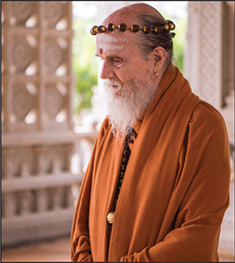 ON A RECENT TEACHING JOURNEY I MET Ravindran, who was raised in India but had lived in the West for many years. He was openly grappling with lingering questions about beliefs he learned while growing up. He shared that Hindus in his region feared that if they didn’t regularly and properly propitiate the Deities of their village, the Gods and Goddesses would be upset, and this would cause negative events in their life. Thus, they were kept busy appeasing a multiplicity of Deities that had been worshiped for generations. The premise of this type of worship is fear, specifically that if we lapse in our ritual obligations we will be punished, or we will suffer, in some way.§
ON A RECENT TEACHING JOURNEY I MET Ravindran, who was raised in India but had lived in the West for many years. He was openly grappling with lingering questions about beliefs he learned while growing up. He shared that Hindus in his region feared that if they didn’t regularly and properly propitiate the Deities of their village, the Gods and Goddesses would be upset, and this would cause negative events in their life. Thus, they were kept busy appeasing a multiplicity of Deities that had been worshiped for generations. The premise of this type of worship is fear, specifically that if we lapse in our ritual obligations we will be punished, or we will suffer, in some way.§
I assured Ravindran that the great Gods of Hinduism do not live in a consciousness of wrath, hurtfulness, judgment, retaliation or pettiness. They are beings of love and light, showering their blessings on each of us, regardless of our failings, frailties and omissions. With this belief as its cornerstone, Hinduism is a joy-based religion in which one never need fear God, never worry that God will be offended or exact some punishment if we do not perfectly perform our puja. Worship in its highest sense is an outpouring of love. God is love and nothing but love.§
My Gurudeva, Sivaya Subramuniyaswami, affirmed: “Hinduism is such a joyous religion, freed of all the mental encumbrances that are prevalent in the various Western faiths. It is freed of the notion of a vengeful God. It is freed of the notion of eternal suffering. It is freed from the notion of original sin. It is freed from the notion of a single spiritual path, a One Way.”§
Ravindran told me more about his village’s belief. When negative events occurred, such as a death of a child, a flood or a sudden illness, the elders looked for lapses in the mandatory rites, believing that the Deities must be penalizing them for neglecting some aspect of the worship. He hoped that a better understanding of the nature of the Gods would help overcome such superstition.§
Hindu philosophy teaches that all events in our life, be they positive or negative, are the result of actions we performed in the past. A distressing situation is a self-created misfortune, not a punishment from God. Life itself, taking place within the realm of duality, is a playground of natural forces, a classroom for embodied souls to experience joy and sorrow, elation and depression, success and failure, health and sickness, good times and bad. The divine beings who reside in the deeper realms of consciousness are always there to assist embodied souls in their journey through samsara. Puja rituals are performed not to propitiate them or mollify their wrath, but to adore them and invoke their blessings and guidance.§
Ritual appeasement does have a scriptural purpose, to protect against the negative energies and efforts of astral entities who actually do seek to upset the lives of embodied souls. Gurudeva taught that the best way to guard against such malevolent beings is to build a positive spiritual force field by invoking the protection of higher and more powerful benevolent beings—the Gods of Hinduism. Astral entities are powerless where there is harmony, cleanliness and close communion with the Gods and their devas.§
On that same journey a teenage boy, leaning forward in earnest, asked, “Do I have to worship all the Deities in the temple, or can I focus on just Lord Ganesha? I am finding that by keeping a singular focus I am getting much closer to Him. I’m beginning to form a connection that I’ve never had with any of the other Deities.”§
I replied in the affirmative, that it is fine to focus on just one Deity. In fact, this is the pattern followed by most Hindus. However, it is only fitting to honor and acknowledge all the Divinities when in the temple. I shared, “When attending puja to another Deity, worship sincerely and show deep respect; but you need not strive to feel as close to that Deity as you do to Lord Ganesha.”§
In Sanskrit, the Deity of one’s most pious attention is called Ishta Devata, literally, “cherished or chosen Deity.” Vaishnavas may choose among many Divine forms: Vishnu, Balaji, Krishna, Radha, Rama, Lakshmi, Hanuman and Narasimha, as well as the Shaligrama, a black-colored fossil found in the sacred river Gandaki. Smartas traditionally choose their Ishta from among six Deities: Siva, Shakti, Vishnu, Surya, Ganesha and Kumara, or any of their traditional forms. Shaktas, who worship the Divine as the Goddess Shakti, may focus on one among Her many forms, from the furious Kali to the benign and graceful Parvati or Ambika. Saivites direct their worship primarily to Siva, as represented by the Sivalingam, Nataraja and Ardhanarishvara. Many Saivites choose Lord Karttikeya, also known as Murugan or Skanda, as their Ishta Devata. My Gurudeva, a staunch Saivite, taught us to worship Siva as the Supreme God while starting with the worship of Lord Ganesha, who is “the closest God to the material plane of consciousness, most easily contacted and most able to assist us in our day-to-day life and concerns.” §
An analogy to friends is helpful. Teenagers have many friends, but it is common to have one best friend with whom we share the most intimate and personal details of our life. Having an Ishta Devata is like that, and the feeling we should have toward that Divinity is the same as the feeling we have for our best friend. Holding a singular focus helps us to draw closer and closer to that Deity.§
Another approach to understanding the Deity’s compassionate nature, and in the process ridding ourself of any lingering fear, is to think of the God or Goddess as the parent and ourself as the child. In fact, the Deity is the perfect parent, because no matter what we do, He/She always sends us blessings and love. When we make mistakes, He never becomes angry or punishes us. The Deity’s love is perfect love, existing at all times, in all circumstances for all souls. xIn developing a closeness with the Deity, we eventually discover and bask in that perfect love. The Tirumantiram affirms this idea: “The ignorant foolishly say that love and Siva are two, but none of them knows that love alone is Siva. When men know that love and Siva are the same, love as Siva they ever remain.”§
In giving talks on the topic of love of God, I often share the similarity of the Vaishnava and Saiva concepts. In the Chaitanya school of Vaishnavism, for example, bhakti is seen as progressing through five stages: neutrality toward God, servitude to God, friendship with God, parental feelings for God, and relating to God as a lover to the beloved. Saivism expresses a parallel concept. The first stage is called the dasa marga, “path of servitude,” with the soul relating to God as servant to master. In the second stage, satputra marga, our relationship is as a child to his parents. In the third stage, sakha marga, God is like a friend. In the fourth stage of maturity, called san marga, or “true path,” God is our dearest beloved. Both denominations emphasize the soul’s coming ever closer to God, in stages that begin with bhakti yoga, which leads the devotee to an intense love of God. Some common bhakti practices are:§
 shravana: Listening to sacred texts and stories of God§
shravana: Listening to sacred texts and stories of God§
 kirtana: Singing devotional hymns and bhajans§
kirtana: Singing devotional hymns and bhajans§
 smarana: Remembering the presence and name of the Divine (this includes mantra repetition)§
smarana: Remembering the presence and name of the Divine (this includes mantra repetition)§
 pada-sevana: Service to the holy feet, which includes serving humanity§
pada-sevana: Service to the holy feet, which includes serving humanity§
 archana: Attending ritual worship in the temple and attending or conducting worship in one’s home shrine§
archana: Attending ritual worship in the temple and attending or conducting worship in one’s home shrine§
 vandana: Prostrating to the Deity§
vandana: Prostrating to the Deity§
 atma-nivedana: Complete self-surrender§
atma-nivedana: Complete self-surrender§
Bhakti yoga develops qualities that make communion possible, such as love, selflessness and purity, leading to self-effacement and surrender to God. It is in this idea of the need for surrender, prapatti, that the members of all sects merge in oneness. We know that we have attained prapatti when we effortlessly know that everything that happens is due to the grace of God and not our own actions. There is no trace of fear in this mode of worship.§
In a letter he wrote to a young man, our paramaguru, Yogaswami (1872–1964), explained the unitive perspective to be held not only toward God, but toward everything. “I am with you and you are with me. There is no distance between us. I am you. You are I. What is there to fear? Look! I exist as you. Then what must you do? You must love. Whom? Everyone. To speak more clearly, your very nature is love. Not only you, but all are pervaded by love. But there is no ‘all,’ for you alone exist. All are you!”§
PUBLISHER’S DESK • JULY 2008§
Who Is the Greatest God?
______________________§
Rivalries abound in the world, even among Hindus, who occasionally vie for the supremacy of their Deity: Vishnu or Siva§
______________________§
BY SATGURU BODHINATHA VEYLANSWAMI§
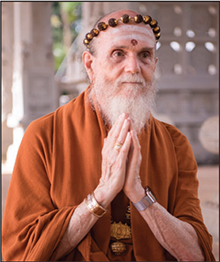 HAVE YOU EVER HEARD A DISCUSSION between two or more Hindus as to who is greater, Vishnu or Siva? As is the case with many philosophical issues in Hinduism, there is, of course, more than one point of view.§
HAVE YOU EVER HEARD A DISCUSSION between two or more Hindus as to who is greater, Vishnu or Siva? As is the case with many philosophical issues in Hinduism, there is, of course, more than one point of view.§
Historically, the rivalry of sects has occasionally become violent. In 1760 two great throngs vying for supremacy clashed on the final day of bathing at the Kumbha Mela in the holy city of Haridwar. Violence ensued, and Saiva and Vaishnava naga babas turned the festival into a killing ground. In all, 18,000 monks died that day.§
In modern times, the rivalries are more verbal than physical, but they are real and not infrequent. In fact, they arise more lately, because Saivas and Vaishnavas are mixing freely. A Hindu family’s friends and neighbors are just as likely to be from another sect—unlike in olden days, when sectarian communities were more isolated and homogeneous. Plus, these days one can find Vishnu and Siva side by side in the same temple, something unheard of even 50 years ago. Such temple arrangements themselves confuse worshipers, provoking them to wonder, “Who is the greatest among the Gods?”§
Our first answer is based on the Vaishnava scripture Srimad Bhagavatam (also called Bhagavata Purana), in which Lord Vishnu/Krishna is the Supreme, all-embracing God of all Gods. The Bhagavatam enjoins devotees of Lord Krishna to not disrespect Lord Siva, but to worship Him as the greatest of the devotees of Lord Krishna. In other words, a Krishna bhakta also prays to Lord Siva, but asks Siva to assist him in attaining devotion to and the favor of Supreme Lord Krishna. The Bhagavatam also contains a story about Siva seated in meditation, eyes closed, chanting on japa beads. It is stated that He is meditating on Lord Vishnu’s transcendental form and chanting Vishnu’s holy names. In the Bhagavatam, Siva is subservient to Lord Vishnu, though He is above the category of an ordinary living being, or jiva. In this position Siva is sometimes referred to as a demigod. In this answer, which represents a Vaishnava point of view, Vishnu is proclaimed to be greater than Siva.§
A second answer is found in a story from the Saiva scripture Siva Purana. Brahma and Vishnu were engaged in an argument about who was greater. The dispute grew so intense that the world was threatened. The devas requested Lord Siva to intervene. Siva appeared before them in the form of a fiery column of light, called Jyotirlinga, of which they could perceive neither the beginning nor the end. A contest was devised by the two: the one who first found either end of the Jyotirlinga would prevail as the greater. Vishnu mounted his boar (varaha) and tunneled downward through the nether worlds; Brahma, mounting his swan (hamsa), ascended through the upper worlds. Failing to find the bottom, and totally exhausted, Vishnu returned to the surface. Brahma, failing to find the summit, resorted to a dishonest ruse. Encountering a ketaki flower falling through space, Brahma cajoled it to falsely testify that He had reached the pillar’s summit. Upon returning to the surface, he was boasting of his achievement when suddenly Lord Siva appeared in the middle of the Jyotirlinga and unequivocally declared Himself to be beyond their ken and thus the greatest. Brahma was castigated by Lord Siva for his deceit. Thus Brahma is not worshiped in any temple in India, except in Pushkar, a few miles from Ajmer, in Rajasthan. In this answer, which represents a Saiva point of view, Siva is manifestly greater than Vishnu.§
Sometimes the rivalry between the Vaishnavite’s staunch adoration of Lord Vishnu and the Saivite’s steadfast adoration of Lord Siva goes to extremes. This is illustrated in a classic story that took place at the Shankaranarayanar Temple in the Tirunelveli District of Tamil Nadu, where the main murti is one half Siva (Shankara) and the other half Vishnu (Narayana). One day an overly zealous Saivite entered the temple to worship the Lord. Before offering incense, he plugged the nostril of Vishnu with cotton to prevent Him from enjoying the fragrance. Seeing that happen, an equally bigoted Vaishnavite made his offering, plugging Siva’s nostril so only Vishnu would enjoy the offering. The story demonstrates the foolish nature of fanatical sectarianism.§
How is it that one Purana extols Vishnu as the Supreme and another elevates Siva? Swami Sivananda, founder of the Divine Life Society, explained, “Vishnu Purana glorifies Vishnu and in some places gives a lower position to Siva. Siva Purana glorifies Siva and gives a lower status to Vishnu. This is only to instill and intensify devotion for the respective Deity in the hearts of the devotees. In reality, no Deity is superior to another. You must understand the heart of the writer.” Swami’s commentary continues, providing a third answer to our question. “Accordingly, the scriptures hold that Vishnu and Siva are ultimately the same. Smarta theologians have cited many references to support this point. For example, they interpret verses both in the Sri Rudram, the most sacred mantra in Saivism, and the Vishnu Sahasranama, one of the most sacred prayers in Vaishnavism, to show this unity… Shri Shankara also has said in very clear terms that Siva and Vishnu are the one, all-pervading Soul.” In this answer, which represents a Smarta point of view, Vishnu and Siva are equal; more precisely, they are identical.§
This same teaching is found in the Shikshapatri, a Vaishnava text written by Bhagwan Swaminarayan. “The Vedas proclaim Narayan and Shiv as one and as Brahmaswarup—God’s true nature—and, therefore, they should be known accordingly.” Bhagwan Swaminarayan enjoins his devotees: “In the month of Shravan they shall worship or engage the services of pious brahmin devotees to worship Shiv with bilva-patras (leaves) and the like.” §
Sometimes the story of the worship of Shankaranarayana by the equally intolerant Vaishnavite and Saivite devotees is marshaled as proof that sectarianism is inherently narrow-minded and all Hindus would be better off being nonsectarian. However, there is another approach to sectarianism, which is the ground for our fourth answer to the question “Who is greater, Vishnu or Siva?” We can call this the tolerant sectarian approach. The Tamil Lexicon, published by the University of Madras, contains these terse but excellent definitions: “Saivam: The religion which regards Siva as the Supreme Being and is exclusively devoted to His worship, of sixteen sects. Vaishnavam: The religion which holds Vishnu to be the Supreme Being.”§
A tolerant sectarian Hindu accepts both of these points and does not conclude that one is true and the other false. They are simply two different names and two different concepts of the Supreme Being. The idea that there can be multiple valid viewpoints about the Supreme is certainly a core Hindu concept. It is captured in the Rig Veda (1.164.46): Ekam Sat viprah bahudha vadanti, “Truth is One, sages describe it variously.”§
Renowned philosopher Dr. S. Radhakrishnan, president of India from 1962-1967, offers a definition of Hinduism that stresses the same point. “The Hindu recognizes one Supreme Spirit, though different names are given to it.” The conclusion of this tolerant sectarian viewpoint is the same as the Smartas’—”Vishnu and Siva are equal.” The basis for this conclusion, though, is different. Here the reason they are equal is that each is the Supreme Being to a different Hindu denomination.§
Clearly there is a need for a tolerant, rather than a fanatical or bigoted, sectarianism in today’s Hindu world. One of the reasons is that many temple societies outside of India have shrines or adjacent temples to both Siva and Vishnu, with priests of both traditions working closely together, and devotees of both denominations attending. §
We had the privilege of attending the 2004 kumbhabhishekam of the Siva temple at the invitation of the Hindu Temple Society of Greater Atlanta. Siva’s sanctum was built adjacent to a temple for Venkateshvara, Lord Vishnu, which had been constructed years earlier. During our visit, we were greatly impressed that Vaishnava priests were helping in the Saiva ceremonies and vice versa. The smooth working together of these two priesthoods, and of Siva’s and Venkateswara’s devotees, was uplifting and encouraging. It shows how well these traditions can cooperate and blend their energies without giving up their distinct beliefs and customs. I have observed this interdenominational harmony elsewhere, including the Hindu temple in Memphis, Tennessee, which, in addition to Vaishnava and Saiva priests, also engages priests of the Smarta tradition.§
In this area, my guru, Sivaya Subramuniyaswami, gave some helpful advice to his followers, who are, of course, Saivites: “Siva’s devotees, with hearts as big as the sky, love and accept Smarta, Shakta and Vaishnava Hindus as brothers and sisters, even if not accepted by them, and keep harmony by not discussing differences.”§
The next time you are involved in a discussion about who is superior, Vishnu or Siva, feel better prepared, as you now have four different points of view to which you can confidently refer. And who knows, you may be inspired to develop a fifth point of view—such is the nature of Hinduism!§

